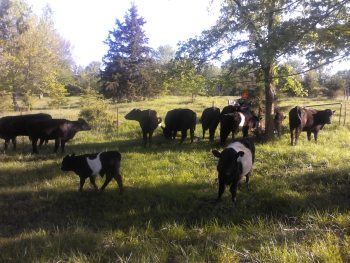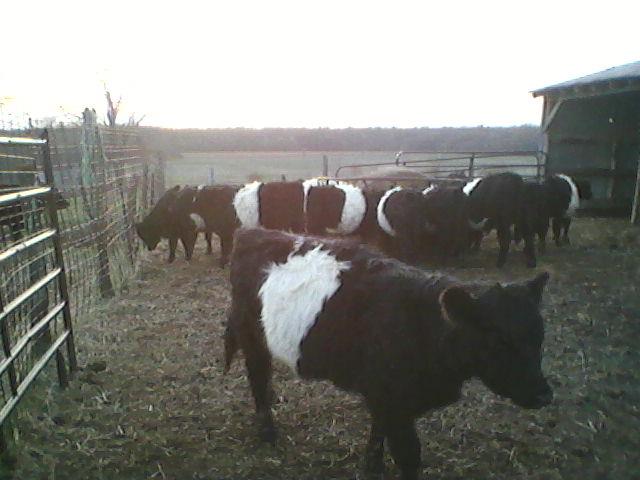Finding the Simple Profit in Wholesale Grass Fed Beef
 For grass fed beef, you really have just two major profit points – as long as you’re feeding hay:
For grass fed beef, you really have just two major profit points – as long as you’re feeding hay:- When they’re weaned.
- When they’re yearlings.
Cost of hay isn’t just baling it, you also have to fertilize the land it came from, or it won’t produce as well for you the next time (and eventually, you’d only be raising short, unpalatable weeds – or sand.)
So working to finish cattle actually takes the remaining profit out of that last 8-10 months. They are going to put on their final weight, but this is also where they lose their efficiency of gain – each pound of gain takes more and more pounds of forage to achieve. And so the relative efficiency of grain-fed beef, who are harvested at about 14 months. That is, if you have the cheap grain to feed them.
Trying to finish cattle on grass usually means another winter of hay, which is additional cost. Auction prices for beef gets you paid commodity prices, which are as low as buyers can get away with. So your fertilizer cost, plus equipment and fuel, eat up any profit from those last few hundred pounds.
Now Missouri has lots and lots of tough, but tasty fescue grass. So this is why it is one of the top beef-producing states. Mostly, it has feeder or stocker (yearling) calves which are then shipped off to feedlots for fattening.
Farmers' Market profits vs. Stockyard Auction prices
 What’s
becoming more popular are grass-finished beef, locally marketed. This
is where you get your premiums and the reason for finishing anything at
all. When you can jump the final price up above your costs for that last
year, you can then simply be able to make any profit you want that the
final consumer will pay for.
What’s
becoming more popular are grass-finished beef, locally marketed. This
is where you get your premiums and the reason for finishing anything at
all. When you can jump the final price up above your costs for that last
year, you can then simply be able to make any profit you want that the
final consumer will pay for.Now while cattle prices are surging all over the place, we are still currently (2012) able to get about $1200 for a steer on the hoof (live-weight). This will give you a your 520-pound carcass and will another $225 processing. While you get about 320 lbs of useful meat from that, you have arount $400 in that animal. Visiting the local big-city farmers' market found that just hamburger from a verified grass-fed beef was bringing $5.50/lb. and sirloin steak was $18-19.00 per pound.
Now, that was individually wrapped, USDA-inspected. (Which nearly doubles the "custom-exempt" fees.) Your break-even would be covering your costs, and then they pay the processing - that's wholesale beef, custom-exempt processed. At farmers' market prices (adding in the high overhead for big-city booth fees), it still shows that farmers taking over their own market can reap the profit harvest to the tune of somewhere around $3- $4,000 per animal.
If you only sell direct at wholesale prices, you can still take your auction price, add in a premium, and get somewhere around $1,000 profit per animal.
Without taking your own marketing into your own hands, you are really stuck with sellling stockers (yearlings) at auction, your next best profit margin.
Our current model is a mix. We turn the bulls into steers and direct market them as wholesale beef when 2 years old. Heifers are sold as feeders (or if they are lucky, picked up as replacement heifers) and we still more than double cost of keeping them overwinter and their shots. An average profit under this model goes around $14-$15,000 for a herd of 22 cows and bull, without other overhead. That's still got about $4200 in winter hay costs.
To create a sustainable farming solution, increasing profit on grass fed beef at commodity prices is to take out the hay costs – which entails something called mob-grazing. By intensively grazing cattle and letting the land recover (one expert at this says his cows only see the same spot twice a year) – this actually make the grass lusher and means you don’t have to feed hay at all, there’s plenty out there if you ration it during the winter.
The other point would be to get a premium above commodity levels – in other words, quit selling a commodity. This means direct marketing all your annual calf crop. With the Internet, this is getting easier.
If we were making $3,000 per steer by USDA inspection and selling to locals on a per piece basis, that would then be a lot more income, but also a lot more overhead in terms of time and expenses.
But I’ve got far more to study on this. A lot more pencils to sharpen and push. I sure would like to move onto finished cattle, but there’s going to have to be some changes in order to “mine them them hills” of grass to see more gold.








No comments:
Post a Comment